In my last post about the Duelund-Altec Project crossovers, I reported on the changes in performance I've heard from the "Stokowski" Altec's Duelund CAST tinned-copper crossovers as they accumulated two weeks worth of run-in time.
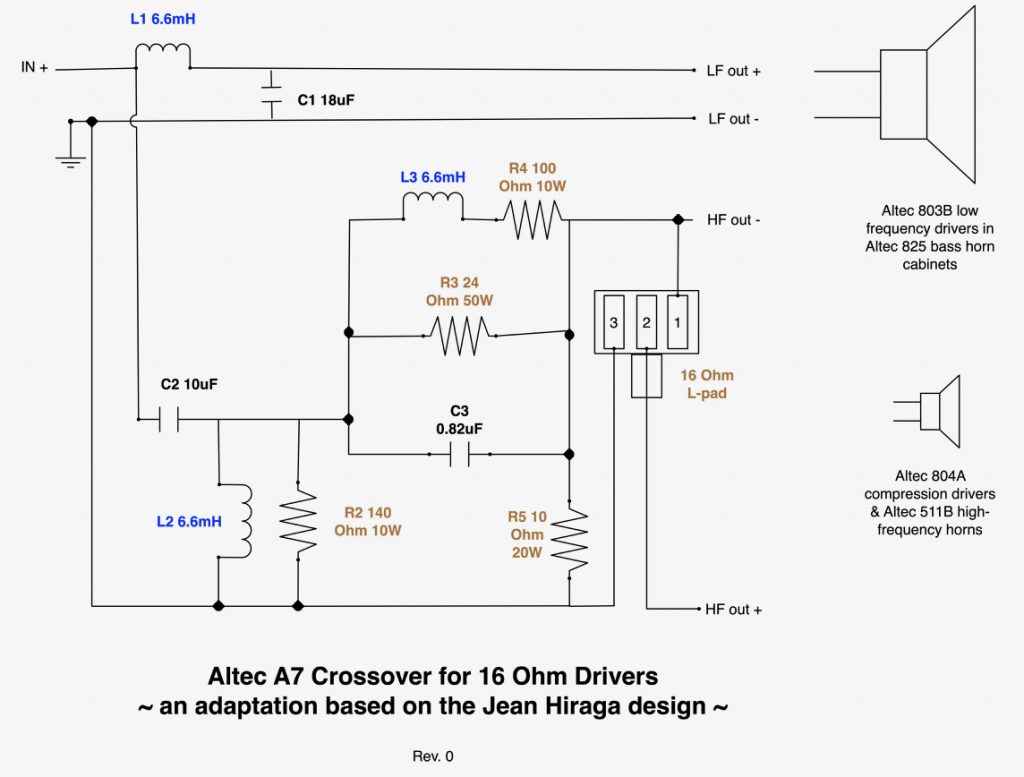
Over the first two weeks I've noted that the high-frequency (HF) and low-frequency (LF) circuits of the crossovers were running in differently in the way their sonic characteristics changed as they accumulated run-in time, and that continues to be the case for the third week of run-in.
Let me talk about the HF and LF circuits separately first, and then I'll describe the overall performance of the crossovers.
Low-frequency circuit performance (500 Hz crossover point and below)
These are the components that make up the LF circuit of each crossover:
- One 6.6mH Duelund CAST tinned-copper inductor for L1.
- One 18uF Duelund CAST tinned-copper capacitor for C1.

6.6mH Duelund CAST Sn-Cu Air Core Inductor at L1.

18uF Duelund CAST Sn-Cu capacitor at C1.
The low-frequency circuit performance has continued to evolve with another week of run-in time, and in fact the aural changes at 3 weeks of run-in time were easily as dramatic in magnitude as they were at the 2 week point.
The low-frequencies are displaying impressive dynamic articulation, from micro to macro, with beat and rhythm becoming major benefactors, to yield a rather incredible live-like musicality for those musical traits.
The transparency has continued to increase in the low-frequencies as well, with enhanced clarity, with more resolution, and the sense of reverberant space around the low-frequency tones has continued to bloom, in an almost DH-SET holographic fashion.
Subtleties of low-frequency harmonic detail and timbral textures continued to evolve and become more evident and articulate.
Just for kicks I did a little 1/3 octave real time analysis (RTA) with music playing to see what it looked like from 500 Hz on down.
I was surprised to see frequency extension down into the low 20's from the 803B low-frequency drivers, and running a little RTA of the music playing was a good reminder for me of how much musical content there was from about 40 Hz to 500 Hz - a lot.
There's a good crossover lesson there: don't shortchange the low-frequency circuit performance of crossovers with average components.
The enhanced clarity, resolution, dynamics, separation of instruments upon the soundstage, etc., that the Duelund CAST tinned-copper components provide are as dramatic on their effect on overall performance in the low-frequency circuit as they are in the high-frequency circuit.
Parts quality matters as much in the low-frequency circuit as it does in the high-frequency circuit.
High-frequency circuit performance (500 Hz crossover point and above)
These are the components that make up the HF circuit of each crossover:
- 6.6mH Duelund CAST tinned-copper inductors at L2 and L3.
- 10uF Duelund CAST tinned-copper capacitor at C2.
- 0.82uF Duelund CAST tinned-copper capacitor at C3.
- 140 Ohm 10W Duelund CAST "Jeffistor" resistor at R2.
- 24 Ohm 50W Duelund CAST "Jeffistor" resistor at R3 (comprised of five 4.8 Ohm 10W Duelund CAST "Jeffistor" resistors in series connection).
- 100 Ohm 10W Duelund CAST "Jeffistor" resistor at R4.
- 10 Ohm 20W Duelund CAST "Jeffistor" resistor at R5 (comprised of two 5 Ohm 10W Duelund CAST "Jeffistor" resistors in series connection).

6.6mH Duelund CAST Sn-Cu Air Core Inductor at L2 and L3.
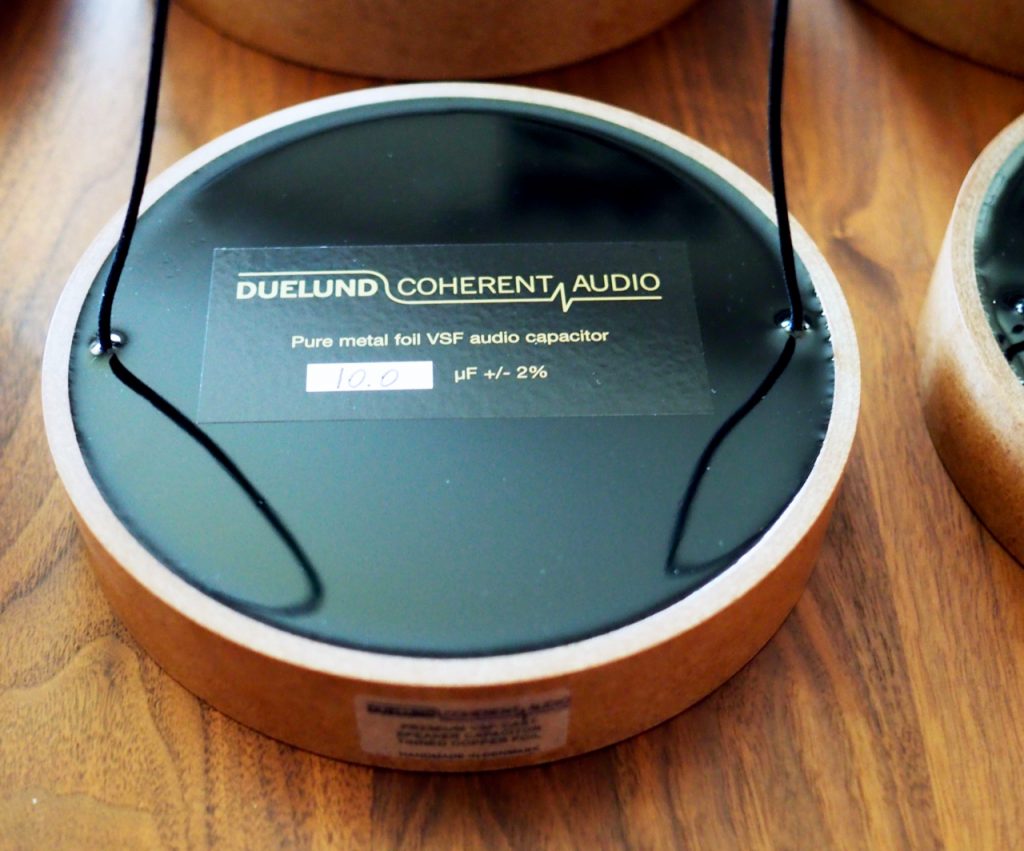
Duelund CAST Sn-Cu 10uF capacitor at C2.
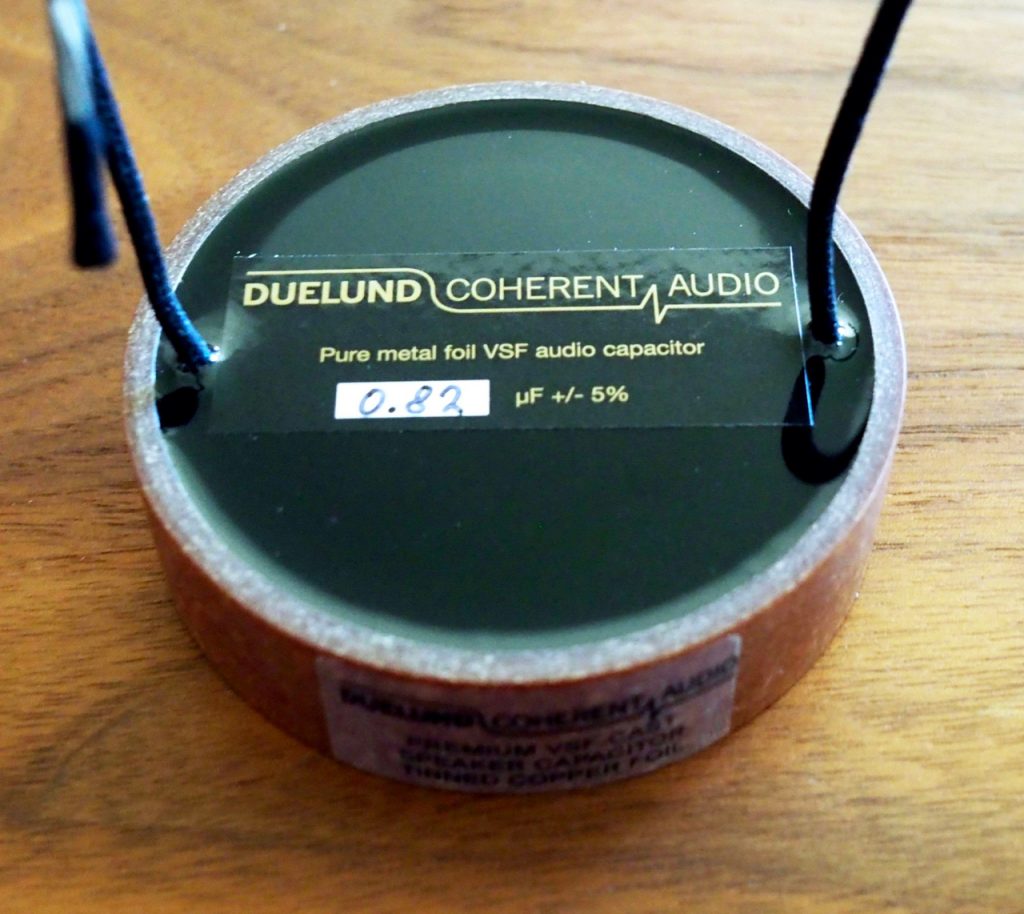
Duelund CAST Sn-Cu 0.82uF capacitor at C3.
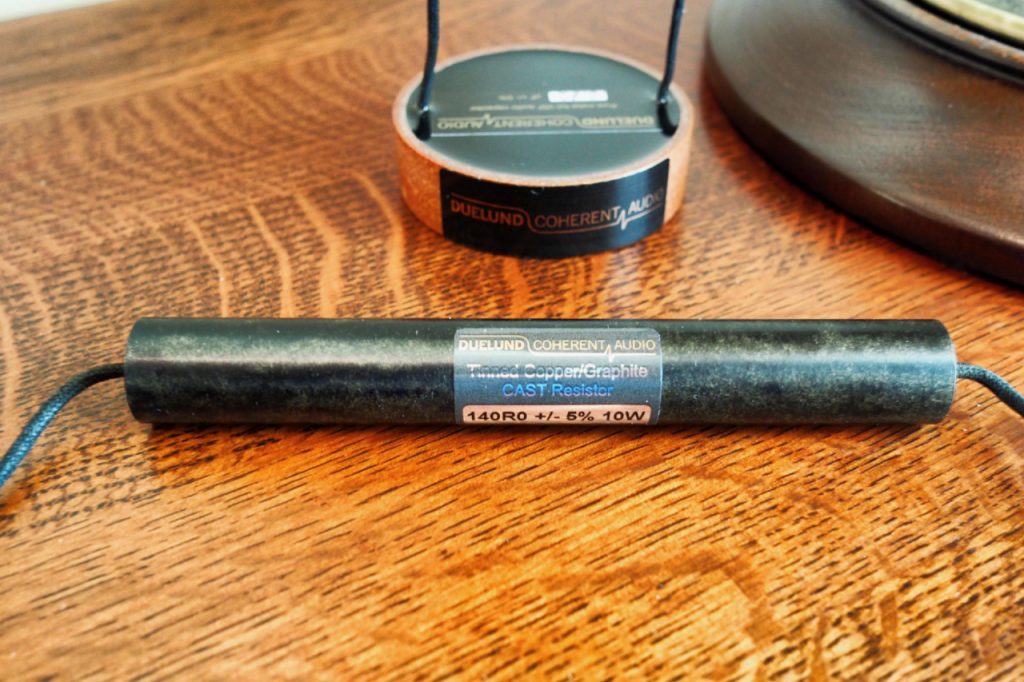
Duelund CAST carbon / Sn-Cu 140 Ohm 10W "Jeffistor" for R2.
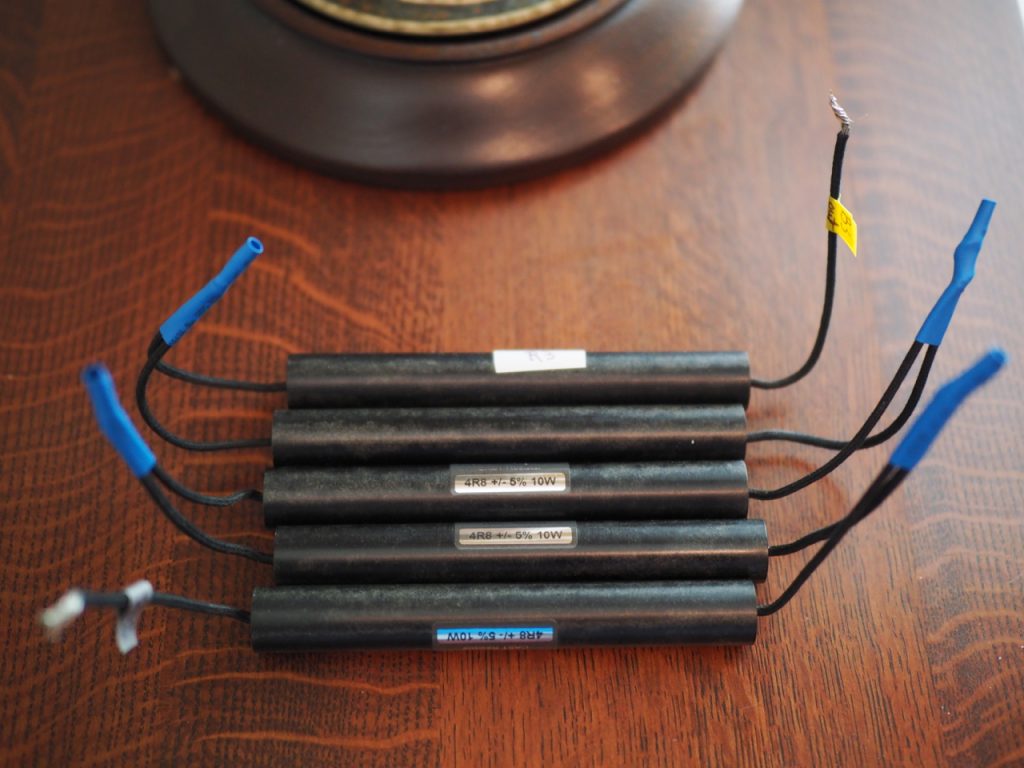
Five 4.8 Ohm 10W Duelund CAST "Jeffistor" resistors in series for R3.
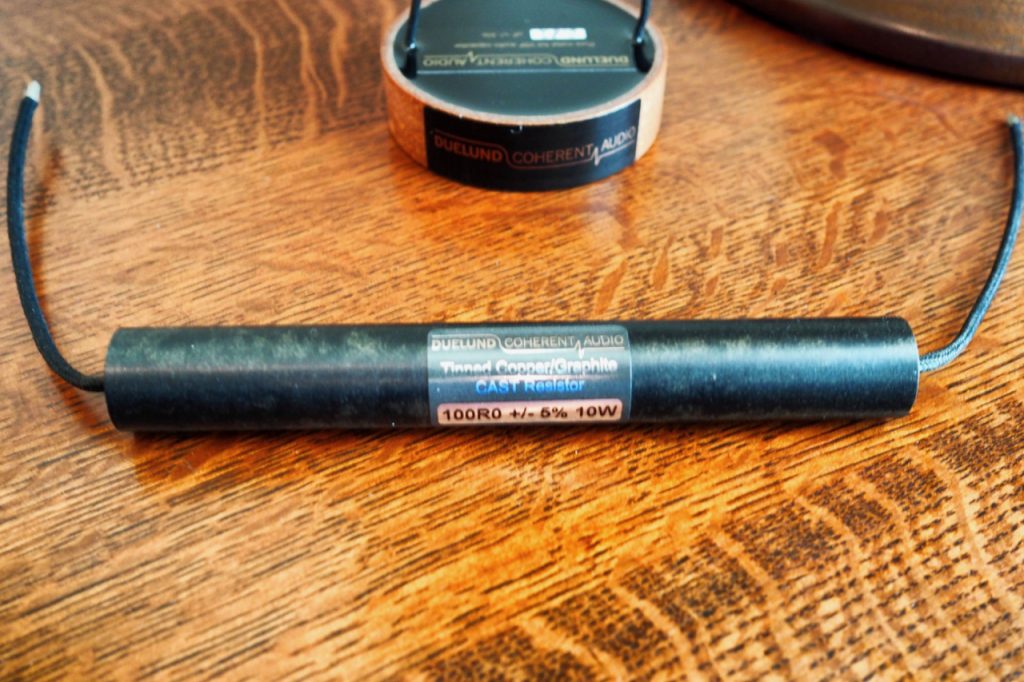
The Duelund CAST carbon / Sn-Cu 100 Ohm 10W resistor for R4.
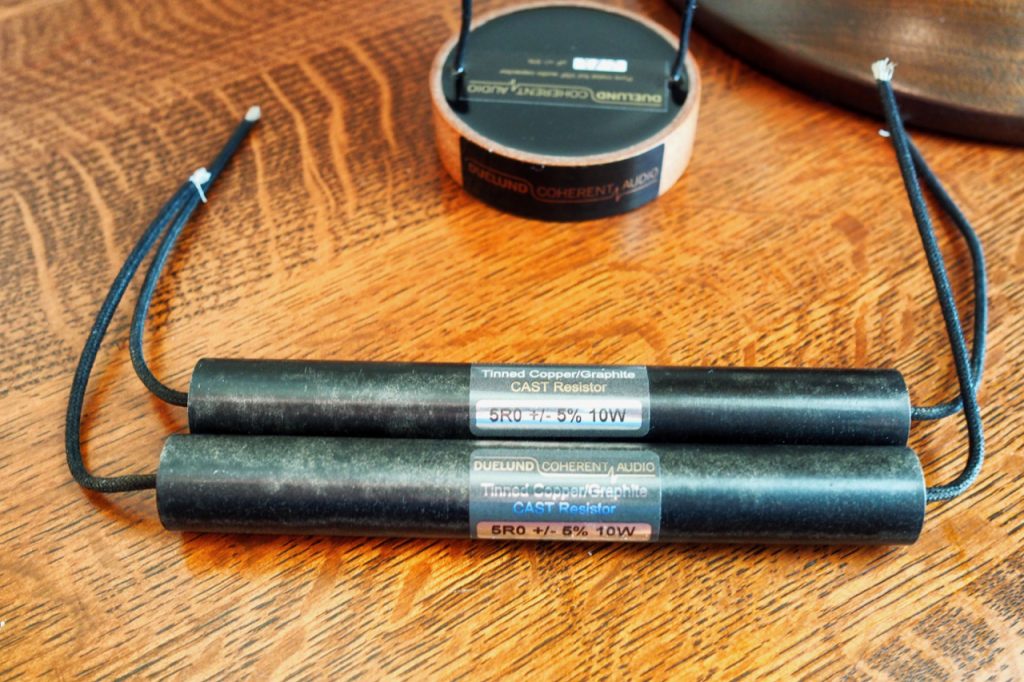
Two 5 Ohm 10W Duelund CAST Carbon / Sn-Cu 5 Ohm "Jeffistor" resistors in series for R5.
During the first week of listening to the Duelund CAST tinned-copper crossovers I noticed a little bit of roughness in the upper midrange, nothing major, but noticeable with careful listening.
By the second week of run-in time much of that roughness had smoothed out, but there was still a little bit of roughness present.
I attributed that roughness I was hearing mostly to the normal run-in process for the DCA16GA tinned-copper wire.
Now after 3 weeks of listening that slight bit of roughness is completely gone, and the high-frequencies sound silky, rich, and gorgeous.
As I reported last week, as the high-frequency circuit gained run-in time I was able to adjust up the L-pad. Now this week I'm able to run the L-pads wide open and the high-frequency balance is superbly natural and articulate.
No forwardness, no unnatural sibilance, just gorgeously natural tone.
Also like last week, I'm able to play at louder live-like volumes with no listening stress or strain in evidence. SPLs in the mid-nineties (with up to 107 dB on peaks) are as relaxed and natural sounding as they are in the mid-seventies, a trait I am particularly impressed by, and a trait that is as rare as hens teeth for a lot of audiophile-style loudspeakers.
All Together Now
The cumulative changes to overall performance have been significant in the third week of run-in time, and I'm back to being struck speechless at the performance I'm hearing from the Duelund CAST tinned-copper crossovers, and finding myself challenged to articulate adequately what I'm hearing.
When there is a major breakthrough in performance like there is with these Duelund CAST tinned-copper components, it takes a while to figure out how to articulate everything I am hearing and feeling from the music.
Overall there is sense of relaxed clarity that is very intoxicating to hear, and which enters into the realm of "feeling" or "experiencing" the music, rather than just hearing how it sounds.
The Duelund CAST tinned-copper components have a way of plugging the emotional content of the music directly into my feelings in a way that is unprecedented in how satisfying and moving it makes the music listening experience feel.
I'm really going to have to mull this over for a while to do justice to articulating the full performance of the Duelund CAST tinned-copper crossovers in the "Stokowski" Altec's.
As you know from reading my scribblings, I am rarely at a loss for words, but I am now. So until I can articulate what I'm hearing a little better, let me close with an excerpt of what Humble Homemade HiFi said about the Duelund CAST tinned-copper capacitors, which also describes nicely what I'm hearing from the Duelund CAST Sn-Cu crossovers:
"It is hard to describe what Duelund CAST Cu-Sn tinned copper foil capacitors can do but they have a certain richness and colour that makes things like voices and acoustic instruments sound very convincing. With "colour" I don't at all mean "coloured", it is more like richer and deeper colours with more nuances. I guess "tangible" is a good word to use to describe them. The sound is intimate and at the same time open. Smooth but never dark ... Comparing the Duelund CAST Cu-Sn to other capacitors, the Cu-Sn seemed to sound more "mature" ... This sense of "matureness" was created by a slightly bigger and more spatious presentation ... With the Duelund CAST Cu-Sn all types of music flow, become more involving, to such an extent that I was forgetting that I was testing capacitors - I haven't had that experience for years ... with the Cu-Sn the overall sound has a fraction more body to it. So by now you must know that I like my music to be as neutral and natural as possible and as coherent as possible. The Duelund CAST Cu-Sn does all these things at an extremely high level - plus it also adds a "being there" effect. The CAST Cu-Sn tinned copper foil capacitor is something special."
You can read the full Humble Homemade HiFi review HERE.
The Path Forward
Patience is a virtue. That's what I keep telling myself as I continue to get more run-in time on the Duelund CAST tinned-copper crossovers, and so far patience has yielded generous improvements in performance as I've continued to accumulate run-in time on the crossovers.
Even though the Duelund CAST tinned-copper crossovers sound fantastic, their performance has not completely stabilized and plateaued yet, so I think another week or so of run-in time is warranted.
The most obvious thing I learned this week was that I can probably remove the L-pad from the high-frequency circuit, as its presence can't be doing anything to help performance, other than balancing the high to low-frequency balance, which it's not really needed for at this point.
Update!
Given the results that I described yesterday with the L-pads probably not being needed any more to adjust the high to low-frequency balance as the Duelund CAST tinned-copper crossovers had accumulated more run-in time, I decided to go ahead and remove the L-pads, and give the Duelund CAST tinned-copper crossovers a listen without them to see if getting them out of the HF signal path would be an improvement overall or not.
So, last night I went ahead and removed the L-pads, and in short, removing the L-pads yielded an across-the-board improvement for the HF circuit performance both musically and sonically.
My first impressions were that everything got better from a musical and sonic standpoint, and I noted in particular that the high-frequencies became even richer and "silkier", with quite a lot more musical nuance resolved.
There was also a nice increase in the presence of the musicians in the room, and in particular, there was a notable increase in the presence of a natural sounding recorded acoustic space that filled my listening room, which had the effect of making everything sound spacious and acoustically gorgeous.
In life, this sense of spaciousness is due to reverberation, where for an auditorium or room an optimum reverberation time would be considered to be around 2 seconds. Sometimes this sense of spaciousness is present naturally, like you hear in some of the old cathedrals when listening to acoustic music.
If a particular venue doesn’t have a reverberation time that is optimum, then it can be artificially created by positioning microphones so that they capture a combination of direct and reflected sound that you will give you the desired reverberation time.
The removal of the L-pads allowed me to hear "into" that sense of spaciousness to a greater degree. While the increase in the sense of spaciousness is not related to the musical content of a recording like vocals and instruments are, the enhanced sense of spaciousness does enhance the listening experience by making it "feel" more like you are sitting in on a live performance, which is an altogether good thing.
The lesson I learned was that while L-pads are a truly useful tool when you need to significantly adjust the high to low-frequency balance of the crossover circuits during the breadboard voicing process, their sound quality doesn't even come close to matching that of a high-quality resistor like the Duelund CAST carbon / tinned copper "Jeffistor".
So, to extend that reasoning a little bit, if I'm trying to maximize my crossovers' performance for a particular room that will remain a relatively constant environment, once I've figured out what fixed resistance value is optimum for balancing the high to low-frequencies for that particular room, I no longer need the adjustability an L-pad offers, and it is likely I can get worthwhile performance gains by replacing the L-pads with high-quality fixed resistors like the Duelund resistors.
Ok, that's all for now, over and out.
You can find links to all of the posts about the Duelund-Altec Project on the archives page HERE.
As always, thanks for stopping by, and may the tone be with you!






























